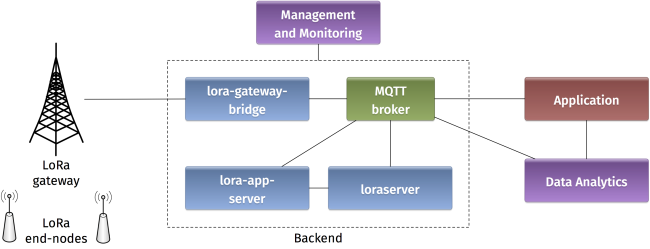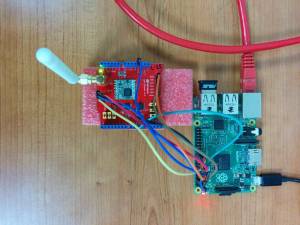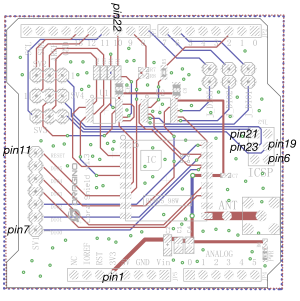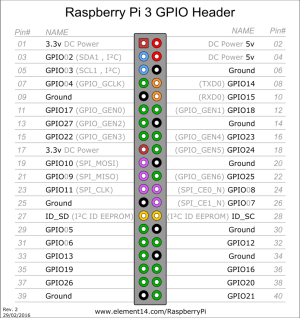Table of Contents
Deploying an End-to-End LoRaWAN Platform
Starting from September 2016, Saint-Joseph University of Beirut (USJ) will be deploying the first academic LoRa network in Lebanon. The network will support monitoring of micro-climate conditions in vineyards. Here below you can find a detailed description of the experimental platform implementing an end-to-end LoRaWAN solution. The platform consists of the following elements:
- Devices that communicate to one or more gateways via a wireless interface using single hop LoRa and implementing the LoRaWAN protocol. These devices are physically connected to sensors that generate data.
- Gateways or base stations that forward frames between the devices and the network server. Gateways are connected to the network server via IP interfaces.
- A LoRAWAN backend that implements the network server functions and provides frame control and security.
- Applications that enable to visualize and store the sensor data obtained from the devices.
1. Devices
1.1 Autonomo with LoRaBee
Starting with the devices in the LoRaWAN platform, we will use an Autonomo board with a LoRaBee Microchip RN2483 module. According to http://shop.sodaq.com, Autonomo is a matchbox-sized powerhouse which uses the new Atmel Cortex M0+ 32bit micro controller. One advantage of such device is that it can be powered by a smartphone-sized solar panel.
In order to configure the Autonomo with LoRaBee device, you should follow these steps:
- Verify that you have the latest Arduino IDE from https://www.arduino.cc/en/Main/Software on your computer.
- Install the board files as noted in http://support.sodaq.com/sodaq-one/autonomо/getting-started-autonomo/.
- Add the following library sodaq_rn2483_2.zip to your Arduino IDE as explained in https://www.arduino.cc/en/guide/libraries.
Now you are ready to write a sketch for the device. Here is one example sketch test-lorawan-combined-loraserver-example.zip where the autonomo is connected to three sensors: light, moisture, and temperature. Let us analyse some extracts of the code.
In this part, you should put the keys for Over-The-Air Activation (OTAA) as explained in the LoRaWAN specification:
// USE YOUR OWN KEYS! const uint8_t devEUI[8] = { }; // USE YOUR OWN KEYS! const uint8_t appEUI[8] = { }; const uint8_t appKey[16] = { };
The pins for connecting the sensors are specified in these declarations (A0 for light sensor, A2 for moisture sensor, and D0 temperature sensor):
int light_pin = A0; int moisture_pin = A2; int temperature_pin = 0; int temperature_vcc_pin = 1; int moisture_vcc_pin = 8; int moisture_gnd_pin = 7;
The OTAA method is used for joining the network and Adaptive Data Rate (ADR) is activated:
LoRaBee.initOTA(loraSerial, devEUI, appEUI, appKey, true)
Eight different sub channels are activated with data rate ranges from 0 to 5:
LoRaBee.configChFreq(0, 868100000L,0,5,1); LoRaBee.configChFreq(1, 868300000L,0,5,1); LoRaBee.configChFreq(2, 868500000L,0,5,1); LoRaBee.configChFreq(3, 867100000L,0,5,1); LoRaBee.configChFreq(4, 867300000L,0,5,1); LoRaBee.configChFreq(5, 867500000L,0,5,1); LoRaBee.configChFreq(6, 867700000L,0,5,1); LoRaBee.configChFreq(7, 867900000L,0,5,1);
Finally, the message containing the sensor values is sent in an unconfirmed uplink message:
LoRaBee.send(1, (uint8_t*)message.c_str(), message.length())
1.2 Arduino with Dragino Shield
1.2.1 Periodic Message Sending
Devices in the LoRaWAN platform can also be implemented on Arduino boards with Dragino shields. The combined module as well as the basic configuration steps are presented in Simple Prototype of LoRa Communications. Similarly to the Autonomo device, you can download the following sketch test-loraserver-comb-loraserver-dragino.zip and modify it according to your preferences. Below you can find somme commented extracts of the sketch.
The pin mapping corresponds to the Dragino electronic schematic:
const lmic_pinmap lmic_pins = { .nss = 10, .rxtx = LMIC_UNUSED_PIN, .rst = 9, .dio = {2, 6, 7}, };
The send function is rescheduled TX_INTERVAL seconds after each transmission complete event:
case EV_TXCOMPLETE: Serial.println(F("EV_TXCOMPLETE (includes waiting for RX windows)")); if(LMIC.dataLen) { // data received in rx slot after tx Serial.print(F("Data Received: ")); Serial.write(LMIC.frame+LMIC.dataBeg, LMIC.dataLen); Serial.println(); } // Schedule next transmission os_setTimedCallback(&sendjob, os_getTime()+sec2osticks(TX_INTERVAL), do_send); break;
The send function is initially scheduled here:
do_send(&sendjob);
The message containing the sensor values is transmitted on one of the radio channels (as in the Autonomo case):
LMIC_setTxData2(1, (uint8_t*) buffer, message.length() , 0);
The adaptive data rate is not supported, and the spreading factor is configured as follows:
LMIC_setDrTxpow(DR_SF7,14);
1.2.2 Triggered Message Sending
You can also find another example of sketch to download: test-loraserver-moisture-on-move.ino.zip. Here the message sending is not periodic but related to an event. For example, an infrared sensor detects a movement and triggers a signal for the device to send a LoRaWAN message. Note also that the join method used in this second sketch is Activation by Personalisation (ABP): the device address, the network session key, and the application session key are directly configured on the device.
2. Gateways
2.1 Single Channel Gateway
The single channel gateway includes a LoRa transmission module (Dragino Shield) connected to a Raspberry Pi (2 or 3) as shown in Figure 2. Communication between the two modules is done over an SPI interface.
In order to assemble the gateway, start by making the wire connections: the connection pins are identified in Figures 3 and 4.
Connect the Raspberry Pi to the Internet and install the packet forwarding software. The source code of the single channel packet forwarder is available on: https://github.com/samerlahoud/single_chan_pkt_fwd. In order to install it, you need to:
- Enable SPI on the Raspberry Pi using raspi-config
- Download and unzip the source code:
wget https://github.com/hallard/single_chan_pkt_fwd/archive/master.zip unzip master.zip
- Install the wiring library:
apt-get update apt-get install wiring
Compile the packet forwarder:
make all
For gcc version 4.6.3, a compilation error results in the following warning unrecognized command line option '-std=c++11'. Replace -std=c++11 by -std=c++0x in the Makefile and recompile:
CFLAGS = -std=c++0x -c -Wall -I include/
Now, you need to configure the single channel packet forwarder. This is done in the global_config.json.zip configuration file. Particularly, you need to choose the channel, the spreading factor, the pins for SPI communication, and the address of the backend server. Note that you can specify multiple backends for testing purposes.
Finally, you can run the packet forwarder as root!
nohup ./single_chan_pkt_fwd &
2.2 Kerlink IoT Station
more /etc/sysconfig/network
# activates eth0 at startup ETHERNET=yes # claims dhcp request on eth0 ETHDHCP=yes # Selector operator APN GPRSAPN=gprs.touch.com.lb # Enter pin code if activated GPRSPIN=0000 # Update /etc/resolv.conf to get dns facilities GPRSDNS=yes # PAP authentication GPRSUSER= GPRSPASSWORD= # Bearers priority order #BEARERS_PRIORITY="eth0,ppp0,eth1" BEARERS_PRIORITY="ppp0,eth0,eth1"
./gps-pkt-fwd.sh > /dev/null &
3270 root 2548 S /bin/sh ./gps-pkt-fwd.sh 3288 root 34908 S ./gps_pkt_fwd
/etc/init.d/gprs start [root@Wirgrid_0b03008c demo_gps_loramote]# /etc/init.d/gprs status pppd (pid 5273) is running... Session: Rx=58, Tx=163 Globals: Rx=1130457, Tx=1195592 Sum: Rx=1130515, Tx=1195755 [root@Wirgrid_0b03008c demo_gps_loramote]#
3. Backend
3.1 Loraserver
The Loraserver has a web interface for configuring the applications and devices on the platform. Full details for installing the software are provided on https://www.loraserver.io.
Start by creating and application as in Figure 5. Then create a node in this application and provide the following information:
- A unique node name
- The node description
- A unique device EUI on 64 bits: Random identifiers can be generated on https://www.random.org/bytes/
- The application EUI on 64 bits: this can be a common identifier for all nodes using the same application.
- A unique application key on 128 bits
In order to enable OTAA join method, you have to make sure that the ABP activation button is unchecked.
3.2 The Things Network
4. Applications
4.1 mqtt-spy
mqtt-spy is an open source utility intended to help you with monitoring activity on MQTT topics. It has been designed to deal with high volumes of messages, as well as occasional publications. mqtt-spy is a JavaFX application, so it should work on any operating system with an appropriate version of Java 8 installed. A very useful tutorial is available on https://github.com/eclipse/paho.mqtt-spy/wiki.
You can use mqtt-spy to debug the messages received from the LoRaWAN devices. For this, you should download the software tool from https://github.com/eclipse/paho.mqtt-spy/wiki. After starting the application, configure a new connection to the MQTT broker by simply adding the IP address of the broker in the Server URI field. Now you can subscribe to any MQTT topic. If you want to receive all messages arriving at the backend, you can use the generic topic #. You can also limit to the topic including the messages of any specific device: application/APPLICATION_ID/node/DEVICE_EUI/rx.



